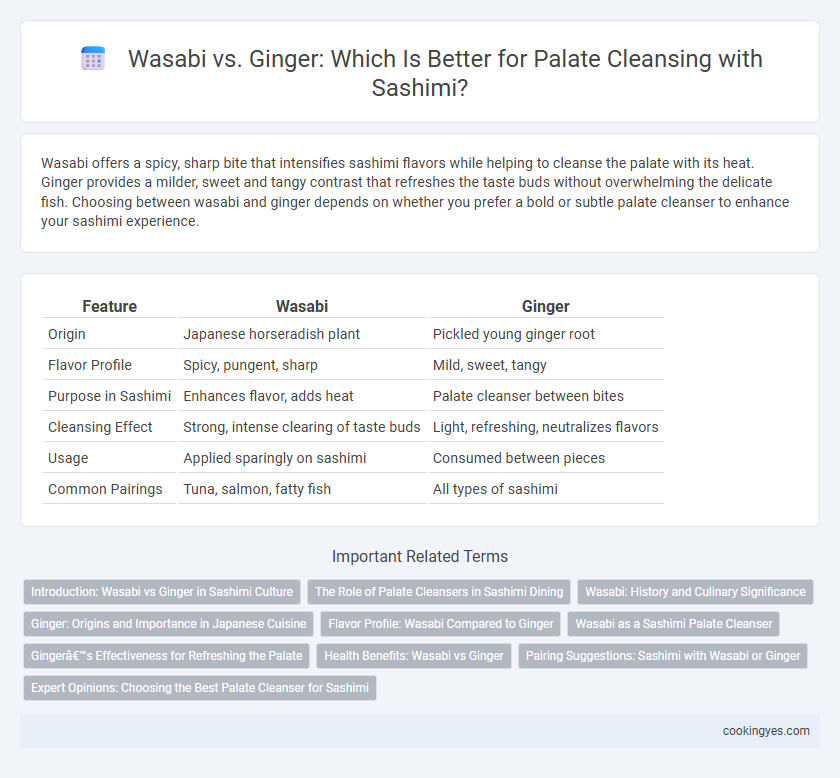Wasabi offers a spicy, sharp bite that intensifies sashimi flavors while helping to cleanse the palate with its heat. Ginger provides a milder, sweet and tangy contrast that refreshes the taste buds without overwhelming the delicate fish. Choosing between wasabi and ginger depends on whether you prefer a bold or subtle palate cleanser to enhance your sashimi experience.
Table of Comparison
| Feature | Wasabi | Ginger |
|---|---|---|
| Origin | Japanese horseradish plant | Pickled young ginger root |
| Flavor Profile | Spicy, pungent, sharp | Mild, sweet, tangy |
| Purpose in Sashimi | Enhances flavor, adds heat | Palate cleanser between bites |
| Cleansing Effect | Strong, intense clearing of taste buds | Light, refreshing, neutralizes flavors |
| Usage | Applied sparingly on sashimi | Consumed between pieces |
| Common Pairings | Tuna, salmon, fatty fish | All types of sashimi |
Introduction: Wasabi vs Ginger in Sashimi Culture
Wasabi and ginger both serve distinct roles in sashimi culture as palate cleansers, with wasabi providing a sharp, piquant heat that enhances the fish's natural flavors while offering antimicrobial benefits. Ginger, often pickled, acts as a refreshing cleanser between bites, neutralizing lingering tastes and preparing the palate for diverse sashimi varieties. Understanding the complementary functions of wasabi and ginger deepens the appreciation of traditional sashimi dining experiences.
The Role of Palate Cleansers in Sashimi Dining
Palate cleansers like wasabi and ginger play distinct roles in enhancing sashimi dining by refreshing taste buds and balancing flavors. Wasabi provides a sharp, pungent heat that heightens the umami of raw fish, intensifying the overall flavor experience. Ginger acts as a mild, aromatic cleanser that neutralizes residual fish oils and prepares the palate for the next bite, ensuring clarity and enjoyment throughout the meal.
Wasabi: History and Culinary Significance
Wasabi, a pungent green paste derived from the Wasabia japonica plant, has been traditionally used in Japanese cuisine to enhance the flavor of sashimi while acting as a natural palate cleanser. Its antimicrobial properties contributed to its historical significance in preserving raw fish, making it an essential complement to sashimi. Compared to ginger, which serves mainly as a refreshing palate cleanser, wasabi offers a unique combination of heat and flavor that heightens the overall sashimi tasting experience.
Ginger: Origins and Importance in Japanese Cuisine
Ginger, known as "gari" in Japanese cuisine, originates from the root of the Zingiber officinale plant and has been an essential palate cleanser in sashimi for centuries. Its natural spiciness and refreshing qualities help neutralize the strong flavors of raw fish, allowing diners to fully appreciate each piece's unique taste and texture. Beyond cleansing, gari's antimicrobial properties contribute to food safety, reinforcing its importance in traditional Japanese culinary practices.
Flavor Profile: Wasabi Compared to Ginger
Wasabi delivers a sharp, pungent heat that intensifies the flavor of sashimi by stimulating the nasal passages, enhancing the fish's natural sweetness without overpowering it. Ginger offers a mild, sweet, and slightly spicy taste that cleanses the palate by neutralizing lingering fish oils and refreshing the taste buds between bites. The contrasting flavor profiles make wasabi ideal for amplifying sashimi's savoriness, while ginger serves as a gentle, aromatic reset for the palate.
Wasabi as a Sashimi Palate Cleanser
Wasabi serves as a superior palate cleanser for sashimi due to its sharp, pungent flavor that effectively neutralizes lingering fish tastes without overpowering the delicate slices. Its antimicrobial properties also contribute to a fresher, safer tasting experience by reducing bacteria typically found in raw seafood. Unlike ginger, which sometimes masks flavors, wasabi enhances the natural umami of sashimi while preparing the palate for the next bite.
Ginger’s Effectiveness for Refreshing the Palate
Ginger is highly effective for refreshing the palate when eating sashimi due to its mild spiciness and natural sweetness, which neutralize lingering fish flavors. Its enzymatic properties aid digestion and enhance taste perception, allowing each piece of sashimi to be enjoyed with a clean, distinct flavor. Unlike wasabi's intense heat, ginger provides a subtle cleanse that does not overpower the delicate texture and freshness of sashimi.
Health Benefits: Wasabi vs Ginger
Wasabi contains potent antimicrobial properties and antioxidant compounds that support immune health and aid digestion, making it beneficial for sashimi palate cleansing. Ginger offers anti-inflammatory effects and promotes gastrointestinal comfort by reducing nausea and enhancing digestion, contributing to a balanced palate. Both wasabi and ginger provide unique health benefits that complement sashimi consumption, improving overall taste experience while supporting digestive wellness.
Pairing Suggestions: Sashimi with Wasabi or Ginger
Wasabi enhances sashimi by providing a sharp, pungent heat that complements the rich, delicate flavors of raw fish, making it ideal for those who enjoy an intense palate cleansing experience. Pickled ginger offers a refreshing, mildly sweet counterpoint that gently cleanses the palate between bites, allowing each piece of sashimi to be savored individually. For an optimal pairing, use wasabi to intensify flavor and ginger to reset the palate, balancing strong and subtle bites in a traditional sushi dining experience.
Expert Opinions: Choosing the Best Palate Cleanser for Sashimi
Expert chefs often emphasize wasabi's sharp, pungent heat as the ideal palate cleanser for sashimi, enhancing the fish's natural flavors without overpowering them. Ginger is praised for its sweet, slightly spicy profile that refreshes the palate and neutralizes lingering tastes between different sashimi pieces. Many experts recommend alternating between wasabi and pickled ginger to balance intensity and cleanse the palate effectively.
Wasabi vs Ginger for sashimi palate cleansing Infographic

 cookingyes.com
cookingyes.com